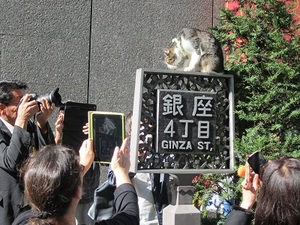Today, I would like to introduce the scenery of my favorite bridge in Chuo-ku.
Chuo-ku has Sumida River, Nihonbashi River, Kanda River, and other small rivers, and faces the sea, so there are canals and many bridges.
Among them, I love Kiyosu Bridge so much that I often see because it is close to my house.
To briefly introduce the profile of Kiyosu Bridge, it was opened in 1928 and was named Kiyosu Bridge from the street name on the opposite bank of Kiyosumi and Nakasu. suspension bridge has an emphasis on aesthetics from the design stage, seeking the elegance corresponding to the arch of Eitai Bridge. The model is said to be based on the suspension bridge of Rhine, which was once in Cologne. In 2007, along with Kachidokibashi and Eitai Bridge, it was designated as a national important cultural property.
I would like to talk about the scenery of Mihashi with a moderate amount of Noh writing. I like walking and jogging along the Sumida River, and I see various expressions of Kiyosu Bridge. What I particularly like is from evening to night. At Kiyosu Bridge, pink light is lit up (currently until 21:00). The beauty of Kiyosu Bridge has a strong presence while Eitai Bridge is light blue, Kachidokibashi is green, and Shin-ohashi Bridge is yellow and green, each of which has its own individuality. This photo shows Chuo-ku from the Koto-ku side on the opposite bank. On the Koto-ku side, Mannen Bridge and the Basho Memorial Hall Branch Historic Site Observation Garden (there is a statue of Basho) are famous places in the neighborhood, but Kiyosu Bridge seen from those directions is well-balanced, and around Mannen Bridge, Cologne There is an introduction to the view. The expression of the bridge and the expression of the river that can be seen as the sun goes down change every moment. After a while, it looks like a night. It's a bridge that doesn't move, but I think the expression changes with the change in light.
This is a photo taken from the Chuo-ku side. In the morning, the sun rises from the Koto-ku side, so the Chuo-ku side first becomes brighter during that time. The photo is a rare one taken on a snowy day. I had the opportunity and photographed from the angle looking down from above, but the scenery from the terrace of Kawahara is not bad. In fact, Eitai Bridge has a solid impression of the image associated with the shape of the arch, but Kiyosu Bridge does not get tired of the elegant impression coming from the shape of the suspension bridge. It is also understandable that there are times when it is said to be a female impression from the contrast. You can also enjoy Kiyosu Bridge by visiting the bridge from Hamarikyu Park and Asakusa by sightseeing boat. Also, it is important to actually cross the bridge in enjoying the bridge. What can be seen from the bridge, Tokyo Sky Tree, Sumida River Fireworks Festival, Tokyo Bay fireworks festival, next bridge, ships passing through the Sumida River, people walking on the terrace, vehicles running through the bridge, etc. In this way, I enjoyed the various scenery created by the bridge.
I've seen the scenery of Kiyosu Bridge in this way, so I introduced my favorite photos here.
How about Kiyosu Bridge?
It is very nice to have such a historic bridge nearby.
There are many other wonderful bridges in Chuo-ku besides here. Why don't you try to find your favorite bridge?


